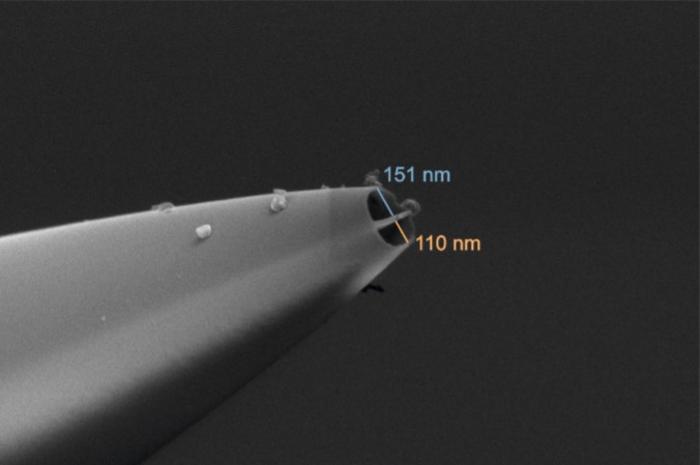Nanopipettes: Versatile Tools for Nanoscale Manipulation and Analysis
What are Nanopipettes?
Nanopipettes are needle-like devices with nanometer-scale tip diameters, typically ranging from tens to hundreds of nanometers. These ultra-small pipettes are fabricated from glass or quartz capillaries and are used for precise manipulation, sensing, and delivery at the nanoscale. Nanopipettes have become essential tools in various fields, including nanoscience, biophysics, chemistry, and medicine.

Fabrication of Nanopipettes
Nanopipettes are typically fabricated using a laser-based pipette puller or a heating and pulling method. The process involves heating a glass or quartz capillary while applying a controlled pulling force, resulting in the formation of a fine tip with a nanoscale opening. The size and shape of the nanopipette tip can be tailored by adjusting the pulling parameters, such as the heating temperature, pulling speed, and delay time.
Advanced fabrication techniques, such as focused ion beam (FIB) milling and electron beam induced deposition (EBID), have also been employed to create nanopipettes with specific geometries and functionalities. These techniques allow for the precise control over the tip size, shape, and surface properties, enabling the fabrication of specialized nanopipettes for specific applications.
Nanopipette Applications
Nanopipettes have found numerous applications in various fields due to their unique capabilities at the nanoscale:
Scanning Ion Conductance Microscopy (SICM)
Nanopipettes are the key component in SICM, a non-contact imaging technique that uses the ion current flowing through the nanopipette tip to map the topography of surfaces with nanoscale resolution. SICM has been used to image live cells, biological membranes, and nanostructured materials, providing valuable insights into their morphology and surface properties.
Single-Cell Analysis
Nanopipettes enable the precise manipulation and analysis of individual cells. By gently touching the cell surface with the nanopipette tip, researchers can extract minute volumes of cellular content, such as proteins, DNA, and RNA, for subsequent analysis. This single-cell approach allows for the study of cellular heterogeneity and the identification of rare cell types within a population.
Nanodelivery and Nanoinjection
Nanopipettes can be used for the controlled delivery of molecules, nanoparticles, and other cargo into cells or specific subcellular compartments. By applying an electrical potential or pressure, the nanopipette can inject femtoliter to attoliter volumes of substances with high precision. This capability has applications in drug delivery, gene therapy, and the study of cellular responses to external stimuli.
Nanoscale Sensing and Detection
Nanopipettes can be functionalized with specific receptors or probes to detect various analytes, such as ions, molecules, and biomolecules, at the nanoscale. By monitoring the changes in the ion current or electrical properties of the nanopipette tip upon interaction with the analyte, highly sensitive and selective sensing can be achieved. Nanopipette-based sensors have been used for the detection of single molecules, pH changes, and chemical gradients.
Nanoscale Patterning and Lithography
Nanopipettes can be employed as nanoscale "pens" for the direct writing and patterning of surfaces with nanometer precision. By dispensing inks, polymers, or other materials through the nanopipette tip, intricate patterns and structures can be created on various substrates. This approach has applications in nanofabrication, nanoelectronics, and the development of advanced materials.
Advances and Future Perspectives
The field of nanopipettes is continually evolving, with ongoing research focused on improving their performance, functionality, and applications. Some of the recent advances include the development of multi-barrel nanopipettes for simultaneous delivery and sensing, the integration of nanopipettes with microfluidic systems for high-throughput analysis, and the combination of nanopipettes with other techniques, such as atomic force microscopy (AFM) and Raman spectroscopy, for multimodal characterization.
Future perspectives in nanopipette technology include the development of smart and responsive nanopipettes that can adapt to their environment, the integration of nanopipettes with artificial intelligence and machine learning algorithms for automated and intelligent manipulation and analysis, and the exploration of nanopipettes for in vivo applications, such as targeted drug delivery and minimally invasive diagnostics.
As nanopipettes continue to evolve and find new applications, they are expected to play an increasingly important role in advancing our understanding of the nanoscale world and enabling breakthrough discoveries in various fields, from fundamental science to medicine and technology.
Further Reading
TrAC Trends in Analytical Chemistry, Confined Nanopipette-A new microfluidic approach for single cell analysis
